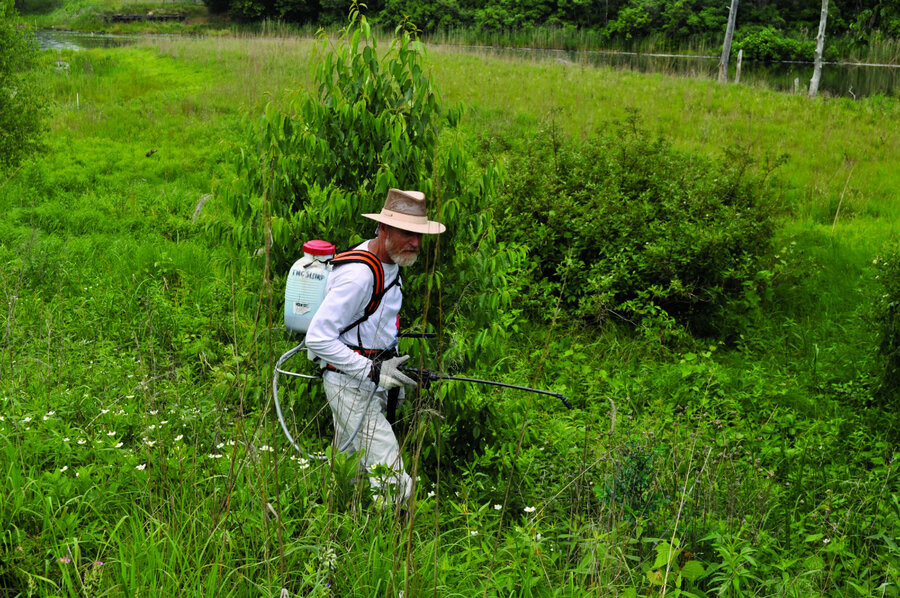In an Indiana river cleanup, businesses and environmentalists cooperate
Loading...
| Gary, Ind.
On a walk near the Grand Calumet River in Gary, Ind., conservationist Paul Labus points out a native orchid called a showy lady’s slipper. He says there are more species of the flower here than in Hawaii. Though Gary is an industrial city, not known for its natural beauty, environmentalists have been working for decades to clean up the area's diverse ecosystem: In the 1950s and ’60s, the Grand Calumet River was identified as one of the most polluted waterways that flowed into Lake Michigan. “[E]very single foot of that river was contaminated,” says Caitie Nigrelli, an environmental social scientist who studied the river. But today, after a decades-long collaboration between private and public interests, much of the river has been environmentally remediated. The discharge water flowing from surrounding industries now runs clear. And the cleanup has seen success in part because of an unprecedented set of negotiations between businesses and environmentalists. “It’s not our goal to always agree – that would be boring,” says Kay Nelson, who represents business interests in those conversations. “But we do talk to one another.”
Why We Wrote This
Industry and environmental interests are often opposed. But in Indiana, a river cleanup requiring both sides to negotiate with each other offers an example for conservation partnerships everywhere.
On a walk through Ivanhoe Dune and Swale Nature Preserve in Gary, Ind., conservationist Paul Labus points out a showy lady’s slipper, an orchid native to the area. He says there are more species of the flower here than in Hawaii.
Gary is an industrial city, not known for its natural beauty. The Nature Conservancy, Mr. Labus’s employer, has worked for the past 30 years to preserve the dune and swale habitat surrounding the nearby Grand Calumet River. The area is home to an unusually diverse mix of species and this season, for the first time in many years, bald eagles have returned to nest along the river’s banks.
But the river wasn’t always so full of life. In the 1950s and ’60s, the Grand Calumet River was identified as one of the most polluted waterways that flowed into Lake Michigan. “[E]very single foot of that river was contaminated,” says Caitie Nigrelli, an environmental social scientist who studied the river.
Why We Wrote This
Industry and environmental interests are often opposed. But in Indiana, a river cleanup requiring both sides to negotiate with each other offers an example for conservation partnerships everywhere.
Raw sewage and untreated water from industries flowed directly into the river from the cities of Gary and Hammond, Ind., and polluted sediment accumulated in the riverbed. By 1967, fish populations were dwindling, and the survivors were deformed.
But today, after a decades-long collaboration between private and public interests, much of the river has been environmentally remediated. The discharge water flowing from surrounding industries now runs clear.
“There absolutely has been substantial progress on the Grand Calumet,” says Ms. Nigrelli. “Sixty percent of the river, based on [mileage], has been cleaned.” The collaboration also created new models for distributing the responsibilities of large-scale cleanups, which have the potential to serve as a blueprint for other regions where industry and nature converge.
In 1972, the arrival of the Clean Water Act, administered by the federal Environmental Protection Agency, marked the beginning of the end for unregulated industrial pollution. In 1987, the EPA named 40 locations as Great Lakes Areas of Concern. Of that group, the Grand Calumet was the most contaminated, with all 14 of the EPA’s pollution assessment measurements checked off. (It only takes one to be put on the list.)
At first, Gary residents found the prospect of cleaning up the river overwhelming. But in the early 1990s, the Citizens Advisory for the Remediation of the Environment Committee – made up of members from government, environmental, and industry groups – was formed to clean up the Grand Calumet. The committee divided the river into sections, making each project cheaper, more manageable, and faster to complete. It allowed the industries responsible for the pollution to look for efficient solutions.
“Northwest Indiana is still an industrial powerhouse, and I say that positively. We’re finding out a way to have industry, dense population, and magnificent nature coexist. And the Grand Cal river is where we’re trying that out,” Nigrelli says.
As of 2012, two of the EPA’s 14 pollution-assessment categories have been cleared. The EPA has lifted restrictions on the consumption of drinking water from the river. U.S. Steel Corp. has successfully dredged a five-mile segment and removed 800,000 cubic yards of contaminated sediment, according to the Indiana Department of Environmental Management (DEM).
Today, along the Dunes Highway toward Chicago, residential areas blend with marshy habitats and industrial plants. While the remediation of the Grand Calumet has been heralded as a success, a large number of remaining sedimentary contaminants still affect fish and wildlife. And the river no longer has natural headwaters; 90 percent of the Calumet is treated water from industries and sewage plants, according to the Indiana DEM.
“The river system itself is not a natural system anymore,” conservationist Labus says.
Nevertheless, Indiana’s experiment in cooperation is drawing attention. Kay Nelson, who represents business interests in negotiations with environmentalists in northwest Indiana, says the conversations have brought about unprecedented environmental improvements, despite the different objectives of the groups involved.
“It’s not our goal to always agree – that would be boring,” says Ms. Nelson. “But we do talk to one another.”
[Editor's note: A job title in this story was misstated. Robert Artunian is a Nature Conservancy staff member.]







